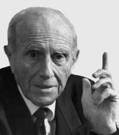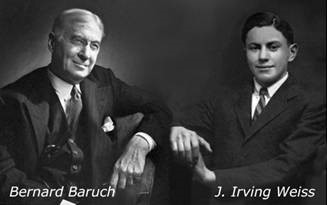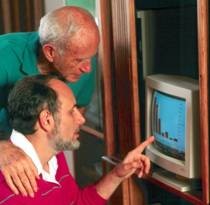

The Weiss Ultimate Portfolio is not a new idea in the Weiss family. In fact, my father, Irving Weiss, first began developing its basic formulas and principles nearly a century ago.
Before he passed away, Dad asked me to compile his writings and teachings about this subject in a single narrative under his name. Here’s it is:
by Irving Weiss (1908-1997)

I’ve been a stock trader since 1929 and a stock analyst since 1932. So I think you can learn something from my experience.
When I first became a customer’s man (stock broker) at a Wall Street brokerage firm in early 1929, no one expected a crash and neither did I.
But I saw how banks were lending huge amounts of money to the brokerage firm I worked for, and how the firm was dishing out that money like candy to our customers to buy stocks. So I decided to track broker loans, an official number that the New York Fed published weekly.
That’s when I realized that the same kind of bank loans to brokers was rampant everywhere on Wall Street and it had a big impact on stock prices. When the broker loans expanded, the stock market rose sharply; when they contracted, stocks corrected.
That’s one of the reasons I completely avoided investing in the market and I told my clients to do the same. So when the crash struck later that year, we were safe. While nearly everyone else lost their shirts, we didn’t lose a penny.
Then, in April of 1930, after the market had enjoyed a big rally, I went further than just abstaining from the market. I borrowed $500 from my mother and used that money to go short the stocks that, according to my careful analysis, were the most vulnerable. Then, whenever I could, I took profits and reinvested those profits in still larger short positions. By the time the market hit rock bottom, I had close to $100,000.
I promptly lost a lot of that money. But looking back, win or lose, it was a great learning experience — one that gave me a far more lasting benefit than money alone: It taught me, on the firing line, how to spot the weakest and strongest stocks.
So when I joined an independent Wall Street research firm in mid-1930s, I was able use that experience to become what my boss called a “crackerjack analyst.”
My specialty was finding companies without debt, plenty of cash and tremendous value — companies that could survive and thrive even in the worst of times. In those Depression years, that was no easy feat. But it made a world of difference for our clients.
Many of our clients were wealthy individual investors that no one had heard of. But some were quite famous, including Sewell Avery, the conservative president of Montgomery Ward; presidential advisor Bernard Baruch; Joe Kennedy, the father of JFK; and others.
Gold mining shares with no debt and great value were among the first ones I looked at, and a small handful of our clients who acted on my advice made fortunes.
Homestake Mining, for instance, went from a bottom of $65 per share after the crash to $130 and change in 1931. From there, it doubled again to more than $350 a share by 1933. By the time it peaked in 1936, it had climbed to $540 a share — an astronomical gain of more than $470 per share. That was a 7-fold increase.
Homestake’s dividends also doubled, redoubled and doubled again — reaching $56 per share in 1935. In fact, the dividends earned in one year alone almost paid back the entire purchase price of the stock.
Dome Mining, another gold producer, did even better. You could have bought Dome for as little as $6 a share after the crash. But in the next seven years, it paid $16.60 in dividends.
The dividends alone were equal to more than 2 1/2 times the cost of the stock. Meanwhile, the price of Dome rose to $61 a share. A person who put $1,000 into Dome could have walked away with more than $10,000 — while nearly everything else remained depressed.
When the market bottomed in 1931, we bought major blue chips — GM, AT&T, GE and Sears — for pennies on the dollar. Again, I chose them because of low debt, plenty of cash and unbelievably good value.
And later, in 1940, I recommended the electric utilities for the same reasons. We bought bonds that were going at 25 cents on the dollar, like Standard Gas and Electric. We bought stocks in Commonwealth and Southern, which were trading on the Big Board, at 10, 15, 16 cents a share.
Another big lesson I learned in the crash was to avoid emotion or bias in stock analysis and stick strictly with the facts. You see, during the Roaring ‘20s, along with big risk-taking, stock analysts were often corrupted.
Investing was based on whims and random tips — not to mention under-the-table payments from companies to analysts. Many people don’t know this, but I remember it vividly. And that’s why we always prided ourselves for our independence and our strict adherence to an objective, statistical approach to stock selection.
Separately, when I was younger, I also had ambitions of becoming a doctor and went to college at nights to prepare. As it turned out, the growing demands of my Wall Street job didn’t allow me to pursue that dream. But a couple of things I learned from the study of anatomy helped guide me in my pursuit of the strongest stocks.
First, I developed what I called the “principle of strong balance.” I came to the conclusion that, to be healthy, a stock company, like the human body, needed strength in all its important functions.
For example, if a man had a bad liver or bad kidneys, even the strongest heart and the healthiest lungs in the world could not overcome those weaknesses. Likewise, if a company had a lot of debt or sick profit margins, even the best sales in the world couldn’t keep it out of trouble.
Later, when more companies began to release more financial data, I used this concept to develop what I called “a total score” that combined the individual scores for each of these critical functions — cash, capital, debt, value, profit margins, earnings, etc.
But unlike some other analysts, I didn’t just add up the individual scores and get an overall average. I made sure the companies had consistently good results on ALL of the important factors. I insisted on good scores across the board. This is what I meant by the principle of strong balance.
Second, I developed the concept of “individual merit.” After witnessing the crash and the Great Depression, I felt we couldn’t rely on the government. So I sought companies that were doing well on their own gas — based on their own internal strength without the benefit of government assistance or government stimulus to their industry.
All of these factors went into my total score, but I never lost sight of our paramount goal — to protect our client’s capital, to always consider safety first.
Meanwhile, a good friend of mine by the name of Arnold Bernhard had also been through the crash, and he founded a small research company that was also developing a scoring system for stocks.
I learned from him, and I think he learned from me, too. His company, Value Line, developed a pretty good track record for evaluating stocks. But over the years, I think they lost their way to some degree. Like the rest of Wall Street, they focused too much on profitability and not enough on safety.
Before and after World War II, I had many great teachers and many excellent students. I was an advisor or mentor for quite a few smart men who were, or later became, famous analysts, economists, investors and publishers.

They included Dick Russell, founder of the Dow Theory Letter; Tommy Holt of Holt’s Advisory; W. M. Kiplinger, founded of the Kiplinger Letter — not to mention the publishers of The Wall Street Journal and Business Week.
But among them all, the one man I could always count on to agree with me on the principals of debt avoidance and strong balance — be it for the country or for selecting sound investments — was Bernard Baruch.
Regardless of what the current fads were on Wall Street or in Washington, he always stuck to his guns. In the early years of the Depression, he was one of the clients I helped to pick the strongest gold mining companies. And he later reciprocated by giving me much-needed moral support in my lifelong battle for a sound dollar.
And of course, I could always count on my family — especially, my brother, Al Weiss, who always double-checked my analysis, and my son, Martin, who came along later and started working with me from a very early age.
Together, we always scrupulously applied all the principles I established from the outset — strict independence of our analysis, safety-first investing and solid balance among all the key factors that make a company strong.
by Martin D. Weiss, PhD

Our Weiss Ultimate Portfolio is the fulfillment of a lifelong ambition. I consider it the ultimate reward, like a pot of gold at the end of a long journey.
You see, nearly everything in my father’s story took place before I was born. I didn’t come along until right after World War II.
But as soon as I was old enough to understand, he began teaching me his analytical skills. He told me bedtime stories about his exploits on Wall Street. And I tagged along when he talked to Bernard Baruch, to Fed Chairman Martin or White House officials in the Eisenhower Administration.
Then, as soon as I could do the arithmetic, he began to show me how to calculate a wide range of ratios on companies — to measure their relative safety and rank their profit performance. That was his great skill.
In the beginning, however, my father and I had to do all the work manually. So we could only analyze a handful of companies every quarter.
My dream was to do much more — to develop systems that could help us accurately review many thousands of companies daily ... and then create a fabulous powerful portfolio around it. Nothing like that had ever been done before.

So before Dad passed away, he and I collaborated with Tony Sagami on a very unique project together: We transferred some of the knowledge inside his brain to a program inside the Weiss Ratings computer. Specifically, I’m talking about ...
(1) His uncanny ability to recognize the beginning and end of major bear markets, plus ...
(2) His analytical skills to avoid unsafe companies, pick out the relatively safe stocks and then select those with the best, most reliable, profit potential.
(3) His principle of strong balance, which required complex computer algorithms (far beyond just assigning different weights to different ratios as most stock research organizations do). Plus ...
(4) His concept of individual merit and insistence on absolute independence which removed any bias from our analyses.
For the last 35 years, I’ve been leading various teams — each team with one analyst and one computer programmer: We’ve had one team for banks, one team for insurance companies, one team for stocks and several more.
Our achievement: With the guidance from crackerjack analysts like Tony Sagami, we built very smart computer models that issue unusually accurate ratings. We started with banks in the early 1980s, then insurance companies in the late 1980s.
We launched our first stock ratings in 1999. And since 2003, we’ve been validating their accuracy, in real time, giving us nearly a decade and a half of experience with their award-winning performance.
Now, we have taken the final breakthrough step: To rank stocks by our proprietary performance index and create a portfolio based on the ultimate in performance by top one-tenth of one percent of all U.S. stocks.
These are the main driving factors in the success of the Weiss Ultimate Portfolio:
To my knowledge, no other investment trading service or organization — let alone a blind black box — identifies and tracks the safest, highest quality, highest performing investments in the world like we do.
No one has systematically pinned down what they are, where they are — let alone how they are shifting over time. No one has cracked the code.
But thanks to my father and the mathematic genius of analysts like Mr. Sagami, we have cracked the code: Among all the strongest industries, asset classes, funds and companies, we identify the tiny handful that sit at the ultimate peak of quality.
Today, based on nearly 90 years of trading market experience and 15 years of stock ratings data, I can say, with a high degree of confidence, that the place and time is here and now. It’s finally the right moment to open up the Weiss Ultimate Portfolio to you.
Home Track Record Benefits Join Now Legacy FAQs Reviews Editor Videos